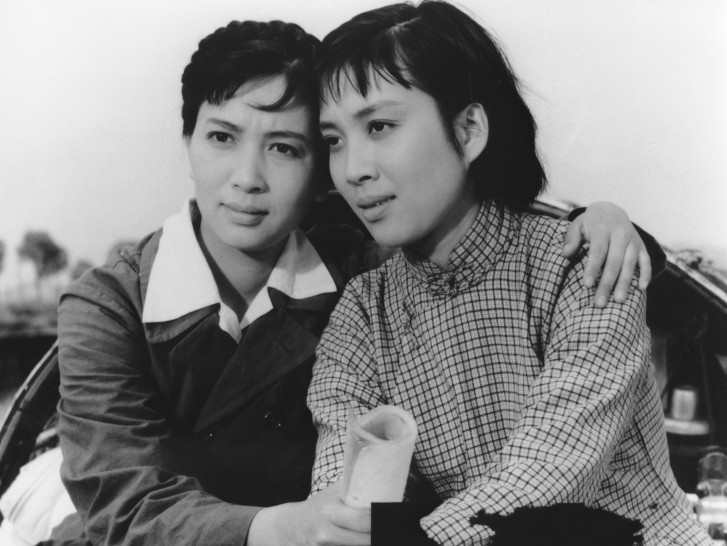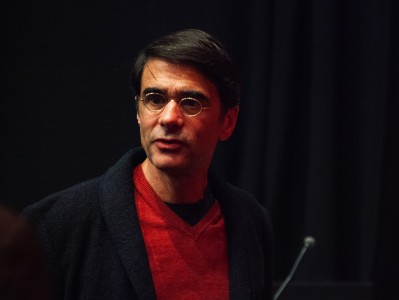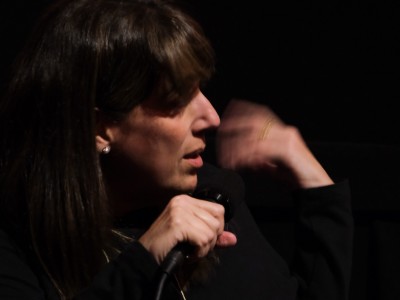
Stage Sisters AKA Two Stage Sisters (Wu tai jie mei) introduction by David Pendleton and Richard Peña.
Transcript
John Quackenbush 0:00
April 22, 2016. The Harvard Film Archive screened Two Stage Sisters. This is the audio recording of the introduction by HFA programmer David Pendleton, and AFVS Visiting Professor Richard Peña.
David Pendleton 0:17
Good evening, everyone. While the latecomers are gathering their seats, I'll just make a few words of introduction for tonight's screening. My name is David Pendleton. I'm the programmer here at the Harvard Film Archive. And it's my pleasure to welcome you all to the second evening, in our retrospective of the work of Xie Jin, most likely, almost unarguably, the most important filmmaker in the history of the People's Republic of China, although someone whose work is not that well known in the United States. But that's something that a number of people have been working on over the last few years and decades, to make the work better known here.
The first thing I should ask is to, for all of you to please turn off your cell phones and devices, and make sure that anything that might make noise or shed light is turned off while the house lights are down, for the pleasure and concentration of all of us.
We opened the program last week with two remarkable films that Xie Jin made shortly before the Cultural Revolution bifurcated the history of filmmaking in the People's Republic of China. That was The Red Detachment of Women, and Big Li, Little Li, and Old Li, both films, I think, remarkable testimony to the vibrancy of Xie Jin’s filmmaking in the 1960s. His career lasted quite long, from the late 1950s into the present millennium. And you can divide it into three sections, if you will: before the Chinese revolution; before the Cultural Revolution, during the Cultural Revolution—when he was one of the few filmmakers who was able to continue working—and then after the Cultural Revolution. We'll be seeing a second screening tonight at 9:30 as well as tomorrow night's screening of Hibiscus Town, are examples of the later work from Xie Jin's career that's included in this retrospective. We're very grateful to the Beijing Film Archive for making prints available.
Tonight, we're actually pleased to be presenting the digital restoration of Stage Sisters, perhaps Xie Jin’s masterpiece, made by, recently by the Shanghai Film Museum and the Shanghai Film Festival. This entire retrospective is presented on the opportunity, or on the occasion of the symposium that took place here at Harvard last Saturday on cinema and the Cultural Revolution. The screenings will go on. After this weekend, there's one more screening the following Sunday. So check your schedules for that.
I did want to thank Assistant Professor Jie Li, of the East Asian Languages and Cultures Department here at Harvard, for her support, as well as the Fairbanks Center and the Department itself. And we have a very special guest tonight to introduce Stage Sisters, somebody who's done more than just about anybody to introduce Xie Jin to American audiences. And that is Mr. Richard Peña. Mr. Peña was, for many years, the head of the New York Film Festival and the Film Society of Lincoln Center. And in his tenure there, really did a great deal to expand the horizons of American cinephiles towards films from China, Iran, and many other places. And we're very grateful to have him here tonight, to say a little bit about Stage Sisters and Xie Jin. He's more recently been a professor at Columbia University. He’s currently a visiting professor here at Harvard, where he was also a student many years ago. Please welcome Mr. Richard Peña.
[APPLAUSE]
Richard Peña 4:04
Thanks so much, David, for that kind introduction. And welcome, everyone. I'm very glad to see such a nice crowd for Xie Jin. This film, in many ways, is for me the kind of masterpiece of a cinema that really began in China in about 1931. There had been filmmaking that went on in China since just about the earliest days. It was really only about 1931-32 that one could say that cinema began to be taken seriously. There was a sense in which, for example, a group, in fact, called the Association of Left-Wing Chinese Dramatists, actually in their kind of charter said, “and we should also go into the cinema. This is a very promising field for us.” And indeed, that led to the creation of, I think, quite a remarkable cinema in China, at that point, that extended through the 30s, 40s, and really up until 1966, when the Cultural Revolution closed down all filmmaking in China, at least for a few years. For me, this film, in many ways, embodies much of what was great about that tradition, in many ways: the narrative style, the use of moving camera, the use of depth of space, all of those kinds of things were things that had been developed from the 30s onward, which reach a kind of magnificent fruition in this film. But the film is also, in its way, a little bit different. And that's what I wanted to talk about. And that is, in its use of what we here in America call, or in the West call “Chinese opera.” Now in China, there's really no separate genre for a kind of musical spectacle called opera. What we say “opera” is basically Chinese theater. All of Chinese theater incorporates recitation, dance, music, singing, acrobatics, martial arts displays, and there are many variants, depending on what the region is. This you're going to see is a version of Shaoxing opera, which was a very special kind of opera that was much beloved of Xie Jin. He was actually not far from that region, and he loved those plays very much, or those operas. So in a way, this is a film that makes reference to that Chinese theatrical tradition, the opera tradition. But even more so, what it does is it tries, I think, more seriously than any other film, to truly find a kind of interface, a kind of adaptation of Chinese opera aesthetic to cinema.
Now this happened, because all through that long period from the 1930s, up until the early 1960s, one could say that most Chinese films adopted what you might call a certain kind of a realist style. The performances were often very naturalistic, as I mentioned, the space was deep, and whatever. In many ways, sometimes people see this as the outgrowth of socialist realism, the influence of the Soviet Union on China. In fact, I think it was much more the influence of Hollywood. You know, these people really liked Hollywood films very, very much, especially from the 1930s, Xie Jin especially. And in a way, that style of filmmaking appealed to them very much. Now, sometimes we see that naturalistic type of performance in this use of space as being almost old-fashioned, conservative in cinematic terms. You must realize, in China this was enormously radical. This was tremendously away from the Chinese tradition, which had been extreme stylization in theatrical or opera performance. So these filmmakers in the 30s and 40s were very deliberately breaking with centuries of Chinese acting, spectacle tradition, when they moved towards what we would call a more naturalistic style of acting and of spectacle presentation.
Now this, as I said, mentioned, went on up until about the early 1960s, at which point it began to be questioned, because if you’ll recall, at that point, China began to break with most of the rest of the world, in a certain way, really trying to not so much cut itself off, but really establish itself away from being part of the socialist bloc and different things like that. When it did that, one of the things that came in for discussion is how do we Sinify the cinema? The cinema is obviously a Western import, whatever, the filmmakers had adopted Western stylistics, how can we bring Chinese elements and aesthetics into filmmaking? I think Xie Jin offers a kind of remarkable solution, in a way, or at least a response, or remarkable response to that question. He not only makes a film about the world of opera, but again and again, introduces a kind of stylization in the way that it's done, so that one can truly say that what we have is kind of like an “opera film.” The way in which the elements and the aesthetics of Chinese opera enter into the cinematic spectacle. The characters really follow the patterns of traditional Chinese opera, the Sheng and Dan performers, the male and female, or the character of the Jing. The Jing in Chinese opera is the painted face, who will often come on, and according to the mask, will tell you if someone's greedy or avaricious, or lustful, or whatever, and often shift the story in that direction.
Curiously, what Xie Jin does here is he has a character who you'll see very, about halfway through the film, named Jiang Bo. And Jiang Bo is a journalist. She's the Jing character. She shifts the film into a kind of larger realm of political consciousness. So in a sense, he's adapting it, and adapting it in a kind of socialist way, showing rather than just anger or lust, now a kind of raising political consciousness. There are many other opera touches in the film, some of which you'll notice, some of which perhaps you won't. I'll ask you to pay special attention to the courtroom scene, which comes near the end, which I think is perhaps the most remarkable sequence in many ways, in seeing how this opera tradition is really expressed in cinema.
Despite all the, as you'll see in the film, the kind of politics, and the praising of the Revolution, whatever, the film was labeled “a poisonous weed” by no less than Jiang Qing herself, and was seen very little when it came out. In fact, you'll see in the film, twice, this magnificent opera, outdoor opera theater, wooden opera theater, that the Red Guard burned down, because they were so angry that it had been used in the film. So really, in a way, the film became almost a watershed moment in that kind of darkening of China that was happening in the mid-1960s. So it has a real pivotal place.
Curiously, of course, a few years later, when the Cultural Revolution did begin making films, what did they make? Opera films. You know, in many ways, it's curious that this film, which most tried to find some middle ground between those disciplines, was attacked, and belittled, and whatever. And then, just a few years later, the Cultural Revolution tried to make their own versions of opera films in that way. This was the last film that Xie Jin would do before the Cultural Revolution. He was sent down, he was sent off to a farm to work. He did not return to filmmaking until 1971. And spent the next few years making versions of model operas, or also shifted by the mid-1970s to making more narrative feature films, but that's a story for another time.
This is a magnificent restoration. I saw it a couple of years ago in Italy, and it really knocked me out. The film was one of the last Chinese films to actually be shot in three-strip Technicolor, because the Chinese had their own Technicolor laboratory. So, unfortunately, you know, we'll never get those prints, but this, I think, probably comes as close as we'll ever have to what the magnificent visual style of Two Stage Sisters might have been. Thank you, and enjoy the film.
[APPLAUSE]
© Harvard Film Archive
Related film series
Explore more conversations
Ken Eisenstein

Guy Madden

João Moreira Salles

Paz Encina

